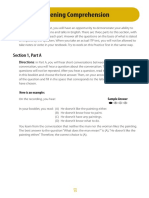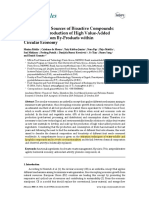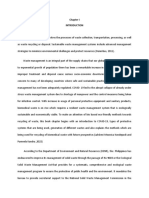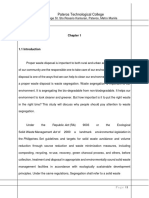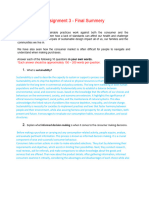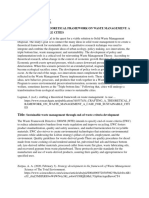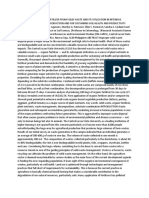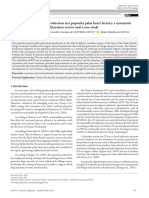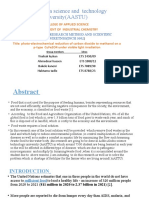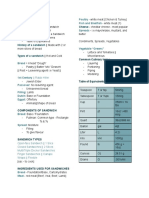Vol.:(0123456789)
1 3
BioEnergy Research https://doi.org/10.1007/s12155-021-10318-9
Valorization of Pineapple Waste: a Review on How the Fruit’s Potential Can Reduce Residue Generation
Isabela Maria Monteiro Vieira
1,2
· Brenda Lohanny Passos Santos
1,2
· Clara Virgínia Marques Santos
2,3
· Denise Santos Ruzene
1,2,3
· Daniel Pereira Silva
1,2,3,4
Received: 8 March 2021 / Accepted: 3 August 2021 © The Author(s), under exclusive licence to Springer Science+Business Media, LLC, part of Springer Nature 2021
Abstract
Pineapple is a fruit of unique appearance and flavor, consumed in natura or processed to obtain different products. How-ever, the processing step generates a series of residues such as crown, stem, cylinder, leaves, and pomace, which have been widely studied due to the high amount of bioactive compounds, dietary fibers, and commercial enzymes found. Different government institutions already established laws detailing treatments required for fruits, like pineapple, and other food waste, either for reuse or disposal. Public policies and waste reuse are necessary to achieve sustainable development, expanding the possibilities for discovering new products and compounds. The current review analyzed different propositions from the literature on the application and valorization of pineapple waste, besides presenting industrial applications for these residues and legislative aspects related to residue treatment policies of different governmental institutions.
Keywords
Ananas comosus
· Food waste · Sustainability · Public policies · Biorefineries
Introduction
Advances made in science and technology, especially in bio-technology, have been assisting humanity in the investiga-tion and exploration of natural resources. New alternatives are studied to improve resource use, which, in many cases, will replace processes and products traditionally harmful to nature. Actions aimed at the reuse of waste have been taken to reduce the environmental impacts caused by anthropo-morphic action, such as the Directive 2008/98/EC, valid for member countries of the European Union (EU) and focused on minimizing the adverse effects that waste generation causes to the environment and human health, with the waste reuse consisting of an excellent alternative for this purpose [1, 2]. Similarly, in Brazil, Law No. 12305/2010, known as
the National Solid Waste Policy, aims to prevent and reduce the production of solid waste through recycling and reuse, in addition to an environmentally appropriate provision for managing the waste generated [3].Constituting a large part of residues generated daily and originated from processes whose objective is to attend human consumption, especially from the agribusiness sec-tor, food wastes contain a large amount of organic matter depending on their origin [4]. The food industry by itself is responsible for generating a wide range of residues, with the cultivation, commercialization, and industrial process-ing of fruits representing large sources of biomasses not used in human food. Despite the current market demand for fresh fruits, there is a worldwide trend in consuming processed ones, which increases even more the waste vol-ume produced, raising companies’ operating costs. The most produced fruit residues are peel, seed, and pomace, a solid waste mixture composed of pulp, peel, stem, and seeds [5, 6]. Among the different fruits explored and consumed world-wide, the current work highlights the potential of pineapple.Pineapple (
Ananas comosus
L.
Merrill
) is considered a flavorful fruit of unique aroma with high nutritional value. Its composition is mainly water and carbohydrates (sucrose,
*
Daniel Pereira Silva silvadp@hotmail.com
1
Northeastern Biotechnology Network, Federal University of Sergipe, São Cristóvão, SE 49100-000, Brazil
2
Center for Exact Sciences and Technology, Federal University of Sergipe, São Cristóvão, SE 49100-000, Brazil
3
Graduate Program in Biotechnology, Federal University of Sergipe, São Cristóvão, SE 49100-000, Brazil
4
Department of Production Engineering, Federal University of Sergipe, Jardim Rosa Elze, Rodovia Marechal Rondon, s/n, São Cristóvão, Sergipe 49100-000, Brazil


BioEnergy Research
1 3
glucose, and fructose), besides some other indispensable substances for human health, such as organic acids, dietary fibers, antioxidants, vitamins, and minerals [7, 8]. In the last
few years, much effort has been dedicated to utilizing pine-apple processing wastes because of the substantial amount of sugars and nutrients found, primarily sucrose, starch, and hemicellulose, which allows their use in several processes and bioprocesses [9].Given pineapple’s growing consumption and waste gener-ation, the present review focuses on the main aspects related to the role of government institutions in the elaboration of policies for waste treatment, analyzing different proposals of applications evaluated by the literature.
Governmental Institutions and Policies for Waste Treatment
Solid Waste
In Brazil, after approximately 20 years of legislative pro-cedures, in 2010, the Law No. 12305/10 established the National Policy for Solid Waste (Política Nacional de Resíduos Sólidos, PNRS), a set of principles, objectives, instruments, guidelines, goals, and actions related to envi-ronmental responsibility and taken by the Federal Govern-ment, singly or in cooperation with the Federal District, states, municipalities, or private entities. The law aimed at the prevention and reduction of solid waste production, pro-posing the adoption of sustainable consumption, recycling maximization, waste reuse (for wastes with economic value, which can be recycled or reused), and policies for the cor-rect disposal of tailings (for wastes that cannot be recycled or reused). Solid waste was considered every material, sub-stance, or object disposed due to anthropomorphic activi-ties, whose final destination is made in the solid, semi-solid, gaseous, and liquid states [3, 10, 11].
The PNRS was an important measure for the Brazilian scenario due to its innovative fundamentals, emphasizing the need for comprehensive waste management, consider-ing environmental, social, cultural, economic, technological, and public health aspects involved in waste management. This policy also contributed to recognizing the economic value of solid waste, whose processing is now supported by law. Before establishing the PNRS, there were only specific national regulations per the type of waste and general rules for its implementation in some territory states. However, 10 years after PNRS and the changes implemented, solid waste management is still deficient in Brazil [10].In the USA and EU member states, there are also regula-tions and legislations for waste management. The Directive 2008/98/EC of the European Parliament and the Council sets measures to protect the environment and human health, focusing on preventing or reducing the impacts caused by waste production and bad management practices [2]. The US Federal Government implements laws to protect human health and the environment through the Environmental Pro-tection Agency (EPA). The agency is in charge of all regula-tions linked to domestic and industrial waste and the manu-facture of solid and hazardous waste through the Resource Conservation and Recovery Act (RCRA) program. RCRA has the role of protecting the community against the dam-ages associated with waste disposal, conserving energy and natural resources through recycling, recovery, and waste reduction or elimination, removing contaminants disposed, leaked, or spilled improperly in the environment [12].The growing concern of society and public agencies with waste production has led to the creation of treatment strate-gies, making even more relevant developing bioprocesses that use waste as raw material, adjusting production to new regulations and laws, and minimizing the associated envi-ronmental impacts. The eighth article of Brazilian Law No. 12305/2010 fits this purpose, making available several PNRS instruments, such as technical and financial coopera-tion between the public and private sectors for the devel-opment of research on new product management methods, processes and technologies, recycling, reuse, waste treat-ment, as well as environmentally appropriate disposal of tailings (item VI); and scientific and technological research (item VII) [3].
Food Industry Wastes
Fruits, vegetables, meats, dairy products, grains, and seafood are some of the food processed daily, generating, in most cases, large amounts of waste arising from the various stages of processing, which make the food processing industry a massive generator of solid waste [5]. This sector uses differ-ent methods and techniques to convert food
in natura
into processed ones with new formats and better durability com-positions. Just as there is no exact estimate of the amount of food waste generated, there is also a lack of reports that accurately determine the amount of waste produced by the food processing industries [13].Nevertheless, taking 2006 as the base year, a study devel-oped by the European Commission estimated a total annual generation of 89 million tons of food waste in 27 member states. Food waste was considered as discarded material in the stages of cultivation, industrial processing, commerciali-zation, and consumption [4].In association with green waste, food waste represents a substantial risk to the environment because it consti-tutes 44% of global waste, making up the largest category of waste generated, followed by dry recyclables (38%), such as plastic, paper and cardboard, metal, and glass [14]. In addition to the high production volumes, the
BioEnergy Research
1 3
carbon footprint left by food produced and not consumed was evaluated at 3.3 Gtonnes of CO
2
equivalent exclud-ing land-use change, significantly contributing to green-house gas emissions [15]. In this sense, there are still a few solutions proposed to minimize solid waste’s harmful effects, and some of the options available are animal feed production, landfill, and composting [6, 9, 13]. Regarding
the waste produced in the field, the measures adopted are incineration or simply natural decomposition [16]. How-ever, incinerating and disposing of food waste in landfills are dangerous practices for polluting soil, water, and air [17]. More specifically, the soil in landfill sites can become contaminated due to the transference of microorganisms and different substances present in the waste, such as pes-ticides contained in effluents from fruit-packaging plants [18]. Food waste is mainly composed of water and biode-gradable compounds that can promote the spread of dif-ferent microorganisms with enough potential to cause dis-eases and allow the reproduction of other living beings as flies and mosquitoes [6, 16, 19]. Water pollution from food
waste can manifest itself in the form of leaching, which can carry contaminants to both surface and groundwater, cause sewage sludge deposition in aquatic environments and landfills from food processing, and the eutrophica-tion of water bodies [20, 21]. Regarding air pollution, as
mentioned before, the carbon footprint left by food waste is very significant, so to continue the practices of incinera-tion and inadequate discharge in landfills will promote the release of more harmful gases into the atmosphere, such as N
2
O, SO
2
, CH
4
, and smoke, in addition to carcinogens compounds as dioxins, polycyclic aromatic hydrocarbons, and furans [16, 20].
The promotion of measures concentrated on reducing the amount of waste generated along the food production chain is a strategy of great importance; however, it is still neces-sary to propose measures to deal with the waste that has been inevitably generated due to industrial food processing [13]. Through biotechnological techniques, the use of food waste for obtaining bioproducts is an attractive alternative that allows adding economic value to a material that would previously be discarded, despite its potential as biomass and nutrient. In parallel, there is a marked minimization of pol-lution due to the decrease in disposals. Solid wastes have a composition rich in carbohydrates, lipids, proteins, miner-als, and bioactive compounds, allowing their application in a wide range of bioprocesses, from biofuel production to obtaining biochemical compounds of commercial interest [13, 19].
In the specific case of fruit processing industries, resi-dues can originate as effluents of residual liquids from juices and washing water; and solids from discarded fruit or pulps, peels, seeds, pomace, or stems [5, 22]. As already
mentioned, such residues can be transformed into new edible products or used as raw materials to recover natural com-pounds to be converted into different bioproducts [22].Several studies are being carried out to assess different fruit residues’ nutritional composition, valuing and direct-ing them to new alternatives for use. Sousa et al. [23] per-formed the nutritional characterization of pulp residues from tropical fruits such as acerola, guava, pineapple, cupuaçu, bacuri, and soursop, attesting their potential as sources of macronutrients and bioactive compounds. Gondim et al. [24] evaluated fruit peels from avocado, pineapple, banana, papaya, passion fruit, melon, and tangerine to determine the proximate composition of seven minerals (Ca, Cu, Fe, K, Mg, Na, and Zn), confirming that, in general, the peels have nutrient contents higher than their edible parts. Silva et al. [25] quantified the levels of resveratrol, coumarin, and other bioactive compounds both in the pulps and in the residues (peel, pulp leftovers, and seeds) of twelve tropical fruits from Brazil, such as pineapple, acerola, mombin, cashew apple, guava, soursop, papaya, mango, passion fruit, surinam cherry, sapodilla, and tamarind. The research also confirms higher concentrations of bioactive compounds in the resi-dues than in their respective pulps.That said, the use of fruit waste by different industrial sectors as pharmaceuticals, food, and cosmetics, for exam-ple, should be encouraged to allow residues to be seen not as expensive and unused materials but as commodities that serve as raw materials for the synthesis of new bioproducts, minimizing both the environmental and economic impacts associated with their accumulation.
Pineapple: from General Aspects to Waste Applications
General Aspects
Native to South America, more specifically in the central and southern regions of Brazil, northeastern Argentina, and Paraguay, the pineapple (
A. comosus
(L.)
Merrill
) and its unique flavor, appearance, and aroma was spread around the world, mainly through European navigators during the sixteenth century, reaching countries like Holland, England, China, India, and the Philippines [8, 26–28].
According to its botanical characteristics, the pineapple tree belongs to the Bromeliaceae family, specifically to the genus
Ananas
. It is a terrestrial, monocot, herbaceous, and perennial plant [28, 29]. For achieving better growth and
fruit qualities, pineapple plants must be cultivated in tropi-cal climates under optimum temperatures from 22 to 32 °C, with an 18 to 24 months’ period from planting to harvest [28, 29]. Adult pineapple plants can have a height between 1
and 2 m with the same width variation, presenting a morpho-logical structure of short and thick stem; gutter-like leaves,
BioEnergy Research
1 3
rigid and narrow; peduncle; multiple fruits; crown; roots, and sprouts [27, 28, 30]. Fixed to the stem, the peduncle
supports the inflorescence that will generate multiple fruits [28, 30]. This fruit is called syncarp and has 100 to 200
individual flowers arranged in a helix shape along with the central cylinder (core). Each flower produces an individual fruit and the fusion of fruitlets will form the pineapple [27, 28, 31]. Figure 1 shows the morphological structure of the
pineapple plant.The varieties of pineapples intended for consumption are part of the species
A. comosus
(L.)
Merrill
. For obtaining fibers or for ornamentation purposes, clones of the species
A. comosus
var.
erectifolius
,
A. comosus
var.
ananassoides
, and
A. comosus
var.
bracteatus
are preferable [28, 32]. Despite
the many existing pineapple varieties, few ones are com-mercially explored. Based on similar characteristics such as plant size, fruit shape, and leaf morphological aspects, the pineapple varieties were divided into five groups: Cayenne, Spanish, Queen, Pernambuco, and Perolera, with the Smooth Cayenne Pineapple being the predominant variety on the market [7, 8, 28].
As already said, pineapple is a much-appreciated fruit, which results in huge production volumes and highly profit-able commercialization, handling billions of dollars annu-ally [33]. On the Food and Agriculture Organization (FAO) report, in 2019, world pineapple production was equivalent to 28,179,348 tons, with a harvested area of 1,125,307 hec-tares, with the three largest producers being Costa Rica, the Philippines, and Brazil [34]. Precisely, Brazil presents a har-vested area of 71,553 hectares, producing 1,766,986 tons of pineapple, whose production value was US$ 551,919 (value converted from Brazilian national currency to the average dollar value in 2018) [33, 35]. The pineapple can be directly
consumed
in natura
or industrially processed to obtain dif-ferent products, namely juice, nectar, jelly, crystallized sweet, raisin pineapple, lyophilized pineapple, pineapple in syrup (slices or pieces), minimally processed pineapple, concentrated frozen pulp, and bromelain — a digestive pro-tein enzyme found in pineapple tissue with well-known anti-inflammatory and anticancer activities [27, 29, 30, 36–39].
Regarding nutritional aspects, pineapple is composed of water, carbohydrates, organic acids, dietary fibers, antioxi-dants, vitamins, and minerals [7, 8]. Among the minerals,
potassium (K) is the most abundant element, followed by calcium (Ca), magnesium (Mg), phosphorus (P), sodium (Na), manganese (Mn), iron (Fe), copper (Cu), zinc (Zn), and selenium (Se) [7, 38, 40, 41]. As for vitamins, the pine-
apple has in its composition vitamins A, B1, B2, B3, B5, B6, B9, and C [27]. The pineapple chemical composition is influenced by specific factors such as cultivated variety, maturation time, climatic aspects, soil composition for cul-tivation, and type of fertilization. That is why it is necessary to pay attention to these parameters to obtain better quality fruits [7, 27, 38].
Pineapple Processing, Consumption, and Associated Waste
Pineapple cultivation generates different residues from the harvest to the final processing stages, either domestic or industrial. More specifically, leaves, stems, and roots are left in the fields after harvest, whereas the processing residues are made up of peel, pomace, core, crown, and effluents. This is because to obtain slices, pulp, or to produce juice, the crown and peel are removed, as well as the core, as shown in Fig. 2 [42]. Although the peel constitutes a large residue per-
centage, the quantities of each type are variable. In a study carried out with two pineapple cultivars (Nang Lae and Phu Lae), the authors determined that the peels corresponded to 29–40% (w/w) of the fruit, while the core, stem, and crown were equivalent to 9–10%, 2–5%, and 2–4% (w/w), respec-tively [43]. In the research developed using the pineapple
Fig. 1
Identification of morphological structures from the pineapple plant


